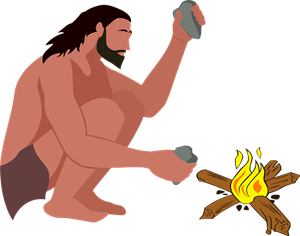
PUMPA - SMART LEARNING
எங்கள் ஆசிரியர்களுடன் 1-ஆன்-1 ஆலோசனை நேரத்தைப் பெறுங்கள். டாப்பர் ஆவதற்கு நாங்கள் பயிற்சி அளிப்போம்
Book Free Demo Early man didn’t know what fire was, but he must have seen the damage it could cause. He must have watched lightning and volcanoes long before he began to use fire himself. Fire was powerful and dangerous, and he was frightened.
Fire may have puzzled early man but we now know that fire is the result of a chemical reaction. When the oxygen in the air combines with carbon and hydrogen in a fuel, a chemical reaction takes place. Energy in the form of heat and light is released in this process. This is what we call fire.
Millions of years ago (during the stone age), the science of starting a fire was discovered. The early humans used rocks to create a fire. Pieces of certain types of rocks were banged together until sparks erupted.

Early man creating fire using flint stones
However, before the humans learned to create and control fire, they might have been scared and disturbed to see one. Volcanoes, forest fires, and lightening and the damage they caused might have caused wonder and anxiety in our ancestors. Check out the following GIF to see how far, wide, and quickly can a forest fire spread.

Forest Fire
Fire is a dangerous element, and it can cause irreplaceable damage if one doesn't know how to control it. It is so powerful that it can spread very fast and can destroy almost everything.
Meanings of difficult words:
No. | Words | Meanings |
1 | Early man | Early human beings; precursors of the human race in its present form |
2 | Frightened | Scared |
3 | Puzzled | Confused |
4 | Chemical reaction | A process that leads to the chemical transformation of one set of chemical substances to another |
Reference:
National Council of Educational Research and Training (2007). Honeycomb. Fire: Friend and Foe (pp. 114-118). Published at the Publication Division by the Secretary, National Council of Educational Research and Training, Sri Aurobindo Marg, New Delhi.